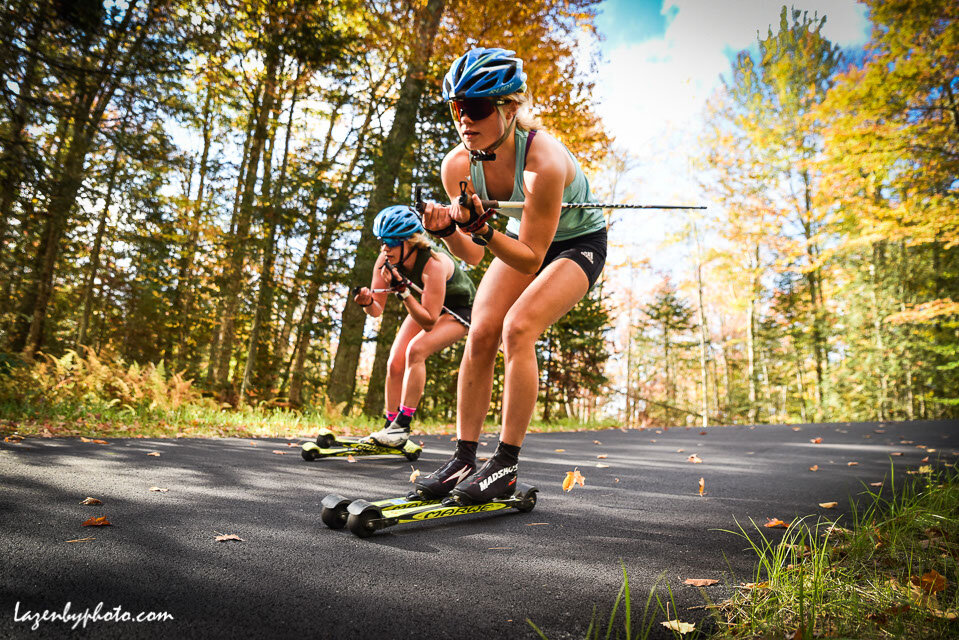What do I need for dryland ski training?
[Ed.: we’re sharing a version of the information we pass to our ski participants around dryland training gear. As such, while we’ve done our best to make this as broadly applicable as possible, understand that some recommendations remain specific to our context. Always talk with your coach or team to be sure that you’re getting gear that works in your training group.]
ROLLERSKIS
Bindings
People very frequently forget to buy bindings when they buy rollerskis. You don’t need the fanciest bindings, but they need to match your boots - and they need to be rollerski-safe! Rollerski-safe bindings are screwed onto the ski, and not just slid onto a plate. This means that if you have rollerskis with an NIS or IFP (Turnamic) plate, you don’t just want to slap your winter bindings on there.
Please have your bindings mounted by a shop or wherever you get your rollerskis from. We discourage skiers from trying to mount your own unless you have a whoooole lot of experience, as slightly misaligned bindings are very annoying and dangerous on rollerskis.
Skate Rollerskis
For a basic, pretty bombproof, functional, cheap-ish rollerski, we recommend an aluminum ski. We always recommend solid rubber, medium speed wheels and a standard length shaft. If it’s labeled “junior,” we recommend that teenage and older skiers steer clear as you’ll wind up with a shorter ski and wheels that are too fast.
Good basic options include: various models of the Pursuit; and Swenor aluminum skate long.
As people rollerski more and more, they typically like nicer rollerskis, which are made of composite materials and dampen the road vibrations a bit. They feel smoother, are usually a bit heavier, and are always a bit more expensive. Many juniors do rollerski on aluminum rollerskis pretty much forever.
Good nicer options include the Swenor Skate Elite and Marwe Skate 620.
Mid-speed wheels are generally the best bet, no matter the ski.
Some people really like speed reducers on their rollerskis. There are pros and cons.
Pros: as you might expect, it’s nice to be able to slow down. That can be a tricky feat sometimes on rollerskis without speed reducers, especially if you’re not super experienced.
Cons: speed reducers can be rattly and loud, which isn’t ideal when skiing on roads as it make it hard to hear cars approaching. They can also be a little hard to apply, depending on the style, and/or uncomfortable (some can chafe the back of the legs).
Our juniors do quite a bit of rollerski agility and speed reducers are not good for that, so we tend to eschew them. Regardless of what direction you go with speed reducers, you should always ski within your abilities and make sure you’ve scouted your route to avoid any sketchy downhills.
Classic Rollerskis
Classic rollerskis are somewhat less straightforward than skate rollerskis - and the nicer ones are a whole lot nicer.
Some aluminum models can less stable sometimes. But aluminum is cheaper. The Swenor aluminum model has been given the thumbs up by our juniors.
Lots of people like the nicer Swenor classic rollerskis, whether the Carbonfibre model (for slightly lighter skiers) or the Fibreglass ones. They feel more like actual classic skiing than aluminum skis because they have a little bit of flex to them. Marwe also makes great classic rollerskis—but like their skate skis, they’re quite pricey. As with skate rollerskis, we recommend mid-speed wheels for classic rollerskiing.
BOOTS
Skate boots
If you use true skate boots in the winter, these will also work for rollerskiing. Combi boots are not great for skate rollerskiing, even if they work pretty well for skate skiing on snow. They tend to be a bit floppy and too flexible when perched up on tall wheels, which leads to feet rolling off of skis, which is dangerous.
Classic boots
Whatever you have will likely work! While not great for skating, Combi boots are quite good for classic rollerskiing, as they provide some additional ankle support.
Fit is important. Classic boots that are too big are not good for rollerskiing, as they let your foot flop around.
POLES
What you choose to use for rollerskiing is a matter of personal preference. Nice poles are nice, but they also break more easily than cheaper poles, and things seem to break more often while rollerskiing.
You can find many different mid-tier poles online or at a local shop that will be just fine for rollerskiing.
Cork grips are recommended. Rubber grips destroy skin.
You need road ferrules. This is non-negotiable.
Pole height
Skate poles should come to the bottom of your nose; classic poles should be 83% of your height with boots on. Either can be a whisker taller, since you stand tall on rollerskis.
Accessories
See the spreadsheet below for miscellany that one needs for dryland.
SAFETY CHECKS
In general, you’re looking for tight (but not over-tight, as that can cause warping and breakage) nuts on the wheel and fork bolts; wheels that have plenty of life in them; wheel bearings that are not overly loud when you spin the wheels; shafts that are totally intact and sound; bindings that are securely screwed into place and close completely; and the absence of rattly binding screws. You should always do a preliminary rollerski gear safety check in the spring or when you get new gear. Even new gear can be wonky and have loose bolts, etc.
Click for a larger version


